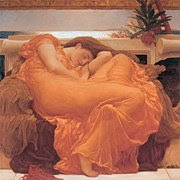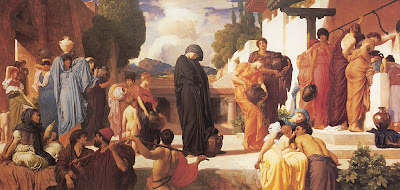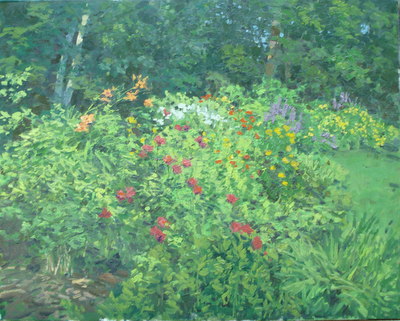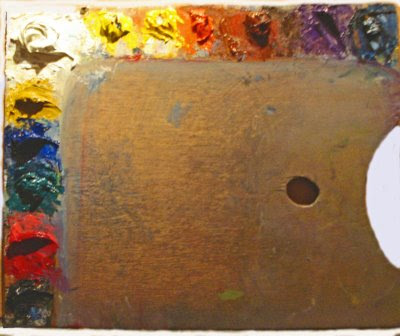
Fredrick Leighton, Flaming June
image from
artrenewal.org.
When I set out to write this blog, my intent was to write down everything I knew about painting. As it progressed I found I was writing a lot about design.
What design means is human intent. Without deliberate intent there is no design. While nature may be arranged in a matter you find attractive,that is not design. Design is an action taken by a human. If you are yourself manipulating the appearance of that before you, you are designing, if you are not, you are transcribing.
I am not arguing that nature isn't beautiful or inspiring. There is a word that is often thought to be synonymous with design and that is composition. But it is not the same thing. It is important not to conflate the two. You may find your composition in nature. You must create a design yourself. That difference is why you have never heard me use the word composition. I always refer to design. Composition refers to the arrangement of something, which it may come by naturally, design refers to a selection and arrangement process by an artist making choices.
I think it is important here to define our terms. Words have meanings. Someone recently argued against using the dictionary definition of design in favor of their own. Were we all to do that we would no longer have a common language with which to communicate. Moreover it would be impossible for me to speak on those occasions when I couldn't reach that person to define my words for me. As the dictionary is constantly accessible and its use is widely accepted in literate circles I hereby establish it as the final arbiter of the exact meaning of words on this blog. When I use the word design, I mean the following:
here follows the definition of design from dictionary.com If you will read through that, I will meet you at the bottom.
–verb (used with object) 1. to prepare the preliminary sketch or the plans for (a work to be executed), esp. to plan the form and structure of: to design a new bridge. 2. to plan and fashion artistically or skillfully. 3. to intend for a definite purpose: a scholarship designed for foreign students. 4. to form or conceive in the mind; contrive; plan: The prisoner designed an intricate escape. 5. to assign in thought or intention; purpose: He designed to be a doctor. 6. Obsolete. to mark out, as by a sign; indicate. –verb (used without object) 7. to make drawings, preliminary sketches, or plans. 8. to plan and fashion the form and structure of an object, work of art, decorative scheme, etc. –noun 9. an outline, sketch, or plan, as of the form and structure of a work of art, an edifice, or a machine to be executed or constructed. 10. organization or structure of formal elements in a work of art; composition. 11. the combination of details or features of a picture, building, etc.; the pattern or motif of artistic work: the design on a bracelet. 12. the art of designing: a school of design. 13. a plan or project: a design for a new process. 14. a plot or intrigue, esp. an underhand, deceitful, or treacherous one: His political rivals formulated a design to unseat him. 15. designs, a hostile or aggressive project or scheme having evil or selfish motives: He had designs on his partner's stock. 16. intention; purpose; end. 17. adaptation of means to a preconceived end. Origin: 1350–1400; ME
designen <> 1. To conceive or fashion in the mind; invent: design a good excuse for not attending the conference. 2. To formulate a plan for; devise: designed a marketing strategy for the new product. 2. To plan out in systematic, usually graphic form: design a building; design a computer program. 3. To create or contrive for a particular purpose or effect: a game designed to appeal to all ages. 4. To have as a goal or purpose; intend. 5. To create or execute in an artistic or highly skilled manner. 1. To make or execute plans. 2. To have a goal or purpose in mind. 3. To create designs. 1. A drawing or sketch. 2. A graphic representation, especially a detailed plan for construction or manufacture. 3. A reasoned purpose; an intent: It was her design to set up practice on her own as soon as she was qualified. 4. Deliberate intention: He became a photographer more by accident than by design. 2. The purposeful or inventive arrangement of parts or details: the aerodynamic design of an automobile; furniture of simple but elegant design. 3. The art or practice of designing or making designs. 4. Something designed, especially a decorative or an artistic work. 5. An ornamental pattern. See Synonyms at figure. 6. A basic scheme or pattern that affects and controls function or development: the overall design of an epic poem. 7. A plan; a project. 1. A reasoned purpose; an intent: It was her design to set up practice on her own as soon as she was qualified. 2. Deliberate intention: He became a photographer more by accident than by design. 9. A secretive plot or scheme. Often used in
tHe has designs on my job.
----------------------------------------------------------------------------------------------------------------------
Here I am again:
I am guessing you didn't read all of that, but the first few entries make the point. I ran it all not to be a wise guy, but because if I were to truncate it, someone could say that I presented only the definitions that served my purpose, so you got it in it entirety.
What all of these have in common is they are deliberate acts taken by a thinking mind. There is nothing in these definitions that gives any idea that design may preexist your selective action.Therefore design is a human act and not a quality of nature, I am going to stand by that statement.
It is entirely possible to make a picture with very little design, It might even be possible to make a picture with no design. To make a picture with very little design you may project a photograph onto your canvas and copy it as exactly as is possible. Since you cropped the photograph and framed the picture in your lens there is some design, but not much.
You can also make a camera of yourself, A MEAT CAMERA. You can stand in front of nature and paint it as exactly as you can, you will of course crop the scene, but that may be all the designing you do. Design implies choice and selection. If you do no selection and make no choices you are not designing
Oddly enough. there was a school of thought in the 1960's and early 70's that sought to do exactly that. They tried to remove
their conscious choices from the
artmaking process by making all of their decisions via randomizing methods. They would throw dice or draw slips of paper from a hat to decide each step in the making of their art, Complicated systems were invented to do this, Many fine teaching jobs were acquired in the process.
Marian said;
Try looking at it this way: Nature (the toy chest) has every shape and size of "building" blocks. The blocks we choose, the blocks we don't choose are all in response to what is observable and what we want people to see.Those building blocks become our structure all from nature. After structure there is design (refinement of structure) and decoration. It is good that we as artists have limits. That is what makes a painting our personal vision that we choose share with the viewer.I like that, and have thought similar things myself. The materials from which to build our painting are laid out before us in nature, but we must pick them up and build with them.The choices we make about how to do that, are design. Just as nature provides us the materials to build a house, we must select through them, choosing that which is useful to us, modifying them to suit our purposes and then decide how to assemble them into a house. Incidentally, Emerson defined nature as "not me".
Gregory said:
I know when I experience something that I would like to share with someone else, it's usually a deeper emotion. If I am trying to incorporate too much in terms of design than the initial reason for painting, I fear, will cause that emotion to slip away from me and that's the part I wanted to share in the first place. My emotions choose my subject. There is already a design in my emotions that points toward beauty. If I try to overwrite that I lose interest. So, how do you design while keeping the original emotional intent? I honestly don't know. I do, however, sense a danger that I am unable to articulate.Gregory. Design is a tool to make it easier to get that emotion from you to the viewer. What you are feeling matters not at all in art, only what you express. By making decisions about how your painting will look you are exercising more expression that if you allow it to be dictated to you by slavishly copying nature or a photograph without adding your own "spin". Incidentally I have been to your web site and seen your art. It is clearly designed and expressive, I can't imagine you not making your own arrangements. Your work seems to me, to be about their arrangement. Apologies if I am wrong, I am aware I am out on a limb when I try to speak for another artists intentions rather than their results.
Jeremy asked;
How do you see design effecting figure drawing? A big part of design is simplification, but you also mention actually moving things about into a more pleasing arrangement. You can't do this with a nose or eye. How do they same principles applyGood question, good figurative work is characterized by good design. I have illustrated this entire post with figurative paintings chosen to show strongly evident design, either in the handling of the stylization of the figures or in the case of this Leighton, the manner in which the figures are arranged across the picture plane. Assembling a work of this sort calls for an enormous amount of design skill. Making a painting like this is probably beyond the abilities of anyone alive today.

Fredrick Leighton, Captive Andromache
Malcolm
Liepke is having a show at Arcadia gallery this month, his paintings are a good example of how a fine designer handles the figure. Generally you may refrain from moving the nose around or adding extra eyes, but there are lots of decisions to be made about arrangement. We have all seen the result of
undesigned figure work, the tired, matter of fact rendition of some bored model from a figure class, rendered accurately but not endearingly. In fact unless you design some rhythm and flow into a figure drawing it will be stiff and inhuman. Mindlessly copying the figure without concern for its form or anatomy gives a stiff and uninteresting, unconvincing figure. I call that look;
NATURE THROUGH A SHOWER DOOR
Seeing as I have been a little
confrontive this evening, and have even told some of you that I feel you are wrong, I will end things on a lighter note. Every day after I write the blog I go to
Facebook and enter a sort of notice that I have written another post. I do this in order to build a little more traffic. I began claiming to include outrageous or ridiculous content in order to capture peoples attention. Here are a few examples of those that I have posted recently.
Some things you won't see in nature, and ancient yogurt amphorae salvaged for the contemporary treacle industry
Post on steelyard compositions. Also a rare map of reflexology temples in 12
th century Missouri.
New post on diagonal compositions. Also dental office rodent color preferences.
New post on
underpainting. Also cosmetics for farm animals and fish.
New post about design, and an amazing story of a Guinea pig that can do long division on an abacus.
New post, its a demo , Also I learned the unsettling truth about
geoducks.
Artists and attitude. Also crafty bivalves dug from solid rock.
New post on being the artist at the opening. Also discreet personal advice for the easily led.
Promoting a show Also hundreds of rabid lemurs frantically paddling leaking
gutta percha liferafts through 50 foot waves.
I have a new post on doing shows and
paintstripper haircuts you can do at home.
==================================================================
Gee, I was going to be nice today too.... tomorrow I will post a picture of some baby animals, or maybe some wax fruit













































